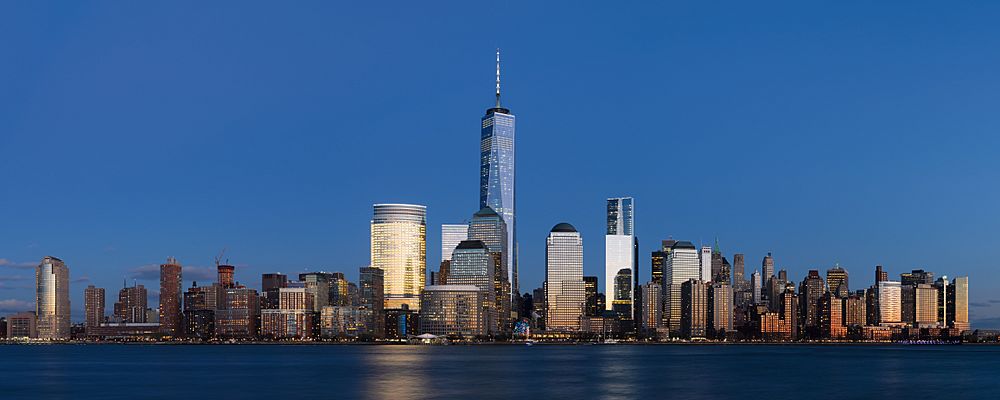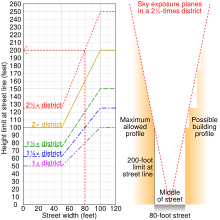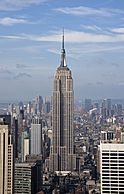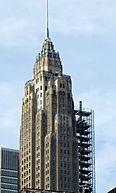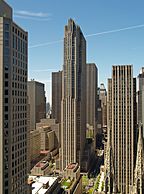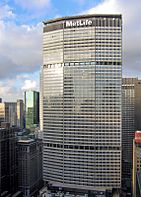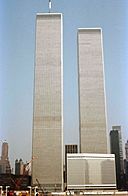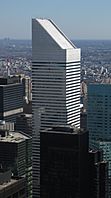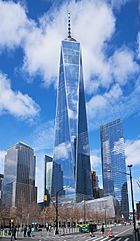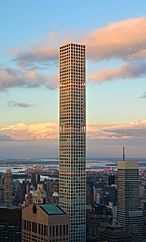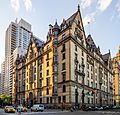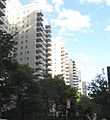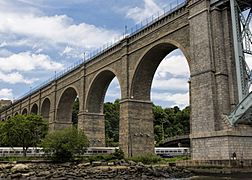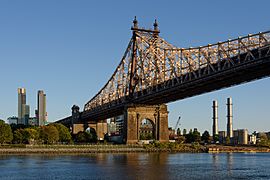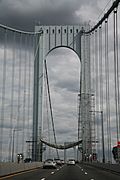Architecture of New York City facts for kids
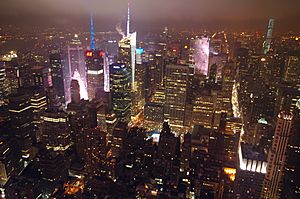
When you think of New York City, you probably picture its amazing skyscrapers! Because the city is mostly surrounded by water, it has grown upwards instead of outwards. This means New York has one of the biggest and most interesting collections of tall buildings anywhere in the world.
New York has many important buildings with different styles from various times in history. For example, the Woolworth Building (built in 1913) is an early skyscraper with a Gothic Revival style, which means it looks like old European cathedrals. In 1916, a special rule called the 1916 Zoning Resolution was made. It said that new tall buildings had to have parts that stepped back as they went higher. This was to make sure sunlight could still reach the streets below.
The famous Art Deco buildings like the Chrysler Building (1930) and the Empire State Building (1931) show off these rules with their tapered tops and pointy spires. Many experts think the Chrysler Building is one of New York's most beautiful, with its unique decorations and shiny steel spire. Later, buildings like 330 West 42nd Street (1931) and the Seagram Building (1958) showed a new, simpler style called the International Style. More recently, the Condé Nast Building (2000) is a great example of green design in a skyscraper, meaning it's built to be good for the environment.
New York's neighborhoods are also known for their elegant brownstone rowhouses, townhouses, and apartment buildings (sometimes called tenements). These were built quickly between 1870 and 1930 as the city grew. But New York also has neighborhoods with fewer buildings, where you can find larger, stand-alone homes. In the areas outside Manhattan, like the outer boroughs, you'll see many single-family homes in styles like Tudor Revival and Victorian.
After the Great Fire of 1835, the city started using stone and brick for buildings instead of wood. Unlike Paris, which used stone from nearby quarries, New York got its building stone from many different places. This is why New York's stone buildings have so many different colors and textures. You might also notice wooden water towers on top of many buildings. In the 1800s, the city required these on buildings taller than six stories. This was to make sure water could reach the top floors without bursting the city's water pipes.
Contents
Tall Buildings in New York

New York City has two main areas with lots of tall buildings: Midtown Manhattan and Lower Manhattan. Each area has its own unique look. Midtown Manhattan is the biggest business district in the world. It's home to famous buildings like the Empire State Building, the Chrysler Building, and Citigroup Center. Lower Manhattan is the third largest business district in the United States. It used to be known for the Twin Towers of the World Trade Center, which were built in 1973 but were destroyed in the September 11 attacks in 2001.
After 2001, Lower Manhattan was rebuilt. This included the new One World Trade Center as part of the new World Trade Center complex. New buildings were designed by famous architects like Santiago Calatrava and Frank Gehry.
New York City has a long history of having very tall buildings. At different times, 10 buildings in New York have held the title of the world's tallest building. The first building to bring this title to New York was the New York World Building in 1890. New York City was home to the world's tallest building for 75 years in a row, starting with the Park Row Building in 1899. This streak ended when the Sears Tower (now Willis Tower) was finished in Chicago in 1974. The 1899 Park Row Building, one of the world's first skyscrapers, is still standing today!
The tall buildings in Brooklyn form a third, smaller skyline. Downtown Brooklyn is also seeing many new luxury apartment towers and businesses being built. The borough of Queens has also been developing its own skyline recently, with buildings like One Court Square (the tallest building in NYC outside Manhattan).
The 1916 Zoning Resolution was a rule that required new buildings to have parts that stepped back as they went higher. This was to make sure sunlight could still reach the streets below.
History of New York's Architecture
The skyscraper has been a big part of New York City's identity since the late 1800s. From 1890 to 1973, the title of world's tallest building was almost always held by a building in Manhattan. Eight different buildings held this title! The New York World Building was the first in 1890, standing 309 feet (94 m) tall. It was torn down in 1955 to build a new ramp for the Brooklyn Bridge. The nearby Park Row Building, with its 29 stories and 391 feet (119 m) height, became the world's tallest office building when it opened in 1899.
Early 1900s Buildings
The 41-story Singer Building, built in 1908, was 612 feet (187 m) tall. It was the tallest building ever torn down when it was demolished in 1967. The Metropolitan Life Insurance Company Tower became the world's tallest building in 1909, standing 700 feet (210 m) tall. Its tower looks a bit like the famous St Mark's Campanile in Venice. The Woolworth Building, with its unique Gothic architecture, took the title in 1913, reaching 792 feet (241 m). Buildings like the Equitable Building (1915), which rose straight up for forty stories, led to the 1916 Zoning Resolution. This rule made sure new buildings had setbacks, meaning they had to get narrower as they went higher to let light reach the streets.
Grand Central Terminal is a famous train station completed in 1913. It was built in the beautiful Beaux-Arts style. It became a National Historic Landmark in 1976.
The 1920s, known as the Roaring Twenties, saw a race to build the tallest skyscraper. Three different buildings tried to get the world's tallest title in just one year! The Bank of Manhattan's headquarters at 40 Wall Street, finished in May 1930, seemed to win at 927 feet (283 m). But then, Walter Chrysler secretly added a 185-foot (56 m) spire to the Chrysler Building. This made it 1,046 feet (319 m) tall and the world's tallest when it was finished in 1929. The Chrysler Building is a famous symbol of New York. It was the first building in the world to go over 1,000 feet!
Both of these buildings were soon beaten by the Empire State Building, which was finished in May 1931. This 102-story building reached 1,250 feet (380 m) to the top of its main structure. A 203-foot (62 m) spire was added later, making its total height 1,453 ft (443 m). The Empire State Building is a modern Art Deco style building in Midtown Manhattan. It was the first building to have more than 100 stories and has one of the most visited observation decks in the world, with about 4 million visitors each year. It was built incredibly fast, in just 14 months!
30 Rockefeller Plaza is another slim Art Deco skyscraper and a key part of Rockefeller Center. It stands 850 feet (260 m) tall with 70 floors. Built in 1933, it was originally called the RCA Building. The carving above the main entrance shows "Wisdom" and a quote from the Bible.
330 West 42nd Street (1931) was the only New York City skyscraper shown in a famous 1932 art exhibition about the International Style. Later, the Seagram Building (1959) was built. Its design has been copied in many buildings around the world.
Late 1900s Buildings
In 1961, there were plans to tear down the old Penn Station and build a new sports arena and office complex. Many people protested to save the beautiful old station. Even though they tried, the station was torn down starting in 1963. Losing Penn Station led to a new law in 1965 that created the New York City Landmarks Preservation Commission. This group helps protect the city's important historic and cultural buildings. This movement has helped save many buildings across the country, including over 1,000 in New York City.
The MetLife Building, once called the Pan Am Building, was the largest office building in the world when it opened in 1963. It stands right next to Grand Central Terminal.
The former Twin Towers of the World Trade Center were in Lower Manhattan. At 1,368 and 1,362 feet (417 and 415 m), these 110-story buildings were the world's tallest from 1972 until the Willis Tower (formerly Sears Tower) was built in Chicago in 1974. One World Trade Center, which replaced the Twin Towers, is now the tallest building in the Western Hemisphere.
Citigroup Center is a 59-story office tower in Midtown Manhattan. It's known as one of the most important skyscrapers built in New York after World War II. Its unique design includes a steeply slanted roof, a shiny aluminum outside, and a base that stands on four stilts over a church. The slanted roof hides the building's machinery. A special "tuned mass damper" was added to the roof later to stop the building from swaying too much.
2000s and Beyond
Time Warner Center is a skyscraper with both homes and businesses. It was the first big building finished after the September 11 attacks.
The Condé Nast Building, also known as Four Times Square, is a modern skyscraper in Times Square. It's a great example of green design in skyscrapers. It uses special systems and insulation so it doesn't need much heating or cooling most of the year. The office furniture is made from materials that are good for the environment. The building also provides more fresh air than required and has recycling chutes. It won awards for being one of the first large buildings to use these eco-friendly features.
Hearst Tower is another example of a new green design skyscraper in New York City. It's a glass and steel building that sits on top of the original 1920s Hearst Corporation Building. You can easily spot it by its cool interlocking triangular glass panels. Hearst Tower was the first skyscraper in New York City to get the special Gold LEED Certified rating, which means it's very environmentally friendly.
Tallest Buildings in New York City
Here are some of the tallest buildings in New York City:
| Rank |
Name | Year Built |
Location (Midtown & Lower Manhattan) |
Floors |
Pinnacle height ft |
Pinn. hgt m |
Standard height ft |
Std. hgt m |
Notes |
|---|---|---|---|---|---|---|---|---|---|
|
1
|
One World Trade Center | 2013 | West Street & Vesey Street | 104 | 1,792 | 546 | 1,776 | 541 | |
|
2
|
Empire State Building | 1931 | Fifth Avenue & West 34th Street | 102 | 1,472 | 449 | 1,250 | 380 | |
|
2
|
432 Park Avenue | 2014 | Park Avenue & East 57th Street (Manhattan) | 89 | 1,396 | 426 | 1,396 | 426 | |
|
3
|
Bank of America Tower | 2009 | Sixth Avenue between 42nd & 43rd Sts | 54 | 1,200 | 370 | 1,200 | 370 | |
|
4
|
Chrysler Building | 1930 | Lexington Avenue & 42nd Street | 77 | 1,046 | 319 | 1,046 | 319 | |
|
5
|
New York Times Building | 2007 | Eighth Avenue between 41st & 42nd Sts | 52 | 1,046 | 319 | 1,046 | 319 | |
|
6
|
One57 | 2014 | West 57th Street between 6th & 7th Aves | 75 | 1,005 | 306 | 1,005 | 306 | |
|
7
|
American International Bldg † | 1932 | Pine, Cedar and Pearl Streets | 66 | 952 | 290 | 952 | 290 | |
|
8
|
40 Wall Street ‡ | 1930 | Wall Street between Nassau & William Sts | 70 | 927 | 283 | 927 | 283 | |
|
9
|
Citigroup Center | 1977 | 53rd Street between Lexington & 3rd Aves | 59 | 915 | 279 | 915 | 279 | |
|
10
|
Trump World Tower | 2001 | First Avenue between 47th & 48th Streets | 72 | 861 | 262 | 861 | 262 | |
|
11
|
Comcast Building (ex-RCA Building and ex-GE Building) | 1930 | 30 Rockefeller Plaza, 6th Ave, 49th & 50th Sts | 70 | 850 | 259 | 850 | 259 | |
|
12
|
CitySpire Center | 1987 | West 56th Street between 6th & 7th Aves | 75 | 814 | 248 | 814 | 248 | |
|
13
|
One Chase Manhattan Plaza | 1961 | between Pine, Liberty, Nassau & William Sts | 60 | 813 | 248 | 813 | 248 | |
|
14
|
Condé Nast Building | 2000 | Broadway between 42nd & 43rd Streets | 48 | 1,118 | 341 | 809 | 247 | |
|
15
|
MetLife Building (ex Pan Am) | 1963 | 200 Park Avenue at East 45th Street | 59 | 808 | 246 | 808 | 246 |
-
- † (built as the Cities Service Company Building)
- ‡ (built as the Bank of Manhattan Trust Corporation Building)
- All addresses are in Midtown Manhattan except those in lighter shades, which are in Lower Manhattan.
Homes and Neighborhoods
-
Gracie Mansion, the mayor's official residence.
-
A large single family home in Forest Hills Gardens, Queens.
-
A Tudor Revival style mansion in Flushing, Queens built in 1924.
-
A home in Tottenville, Staten Island.
-
Houses placed on Hawtree Creek in Howard Beach, Queens.
-
21st century apartment towers in Long Island City, Queens.
-
Tall apartment buildings on the Williamsburg, Brooklyn waterfront.
-
Queen Anne style home from 1899 in Dyker Heights, Brooklyn.
-
Dakota Building (1881) on the Upper West Side of Manhattan.
-
Tenement buildings in the Lower East Side.
-
Brownstone townhouses in Harlem.
-
Manhattan House buildings in the Upper East Side.


As New York City grew, it spread out from its original spot at the southern tip of Manhattan Island. Farmland and open spaces in Upper Manhattan, the Bronx, Queens, Brooklyn, and Staten Island became neighborhoods filled with brownstones, apartment buildings, and single-family homes. How many buildings were packed into an area often depended on how close it was to Manhattan and how easy it was to get there.
New bridges and public transportation often helped these areas grow. For example, the Brooklyn Bridge was finished in 1883. It connected Brooklyn and Manhattan across the East River. This made it easier to travel between the two areas and led to a lot of building in Brooklyn. The Verrazano-Narrows Bridge, completed in 1964, also helped many parts of Staten Island grow, especially in the central and southern areas that were mostly undeveloped before. Staten Island's population doubled between 1960 and 2000!
By 1870, stone and brick became the main building materials. This happened after the Great Fire of 1835 showed that wooden houses could burn too easily. New York got its building stone from many different quarries, sometimes far away. This is why you see so many different textures and colors of stone in the city's buildings. In the past, stones were brought by boat down the Hudson River or along the coast from places like New England. Later, trains brought marble from Vermont and granite from Minnesota. But it was Connecticut brownstone that became so popular for New York's row homes in the late 1800s that "brownstone" became another word for a row house.
Starting in the 1950s, large public housing projects changed the city's look. New, often tall, apartment complexes replaced older communities. These projects were built to renew parts of the city. However, many of these projects have faced problems like not enough money for upkeep and high crime.
A special thing you'll see on many New York City buildings (both homes and businesses) are wooden water towers on the roof. These were required on all buildings taller than six stories in the 1800s. This was because the city's water pipes couldn't handle the very high pressure needed to send water all the way to the top floors of tall buildings.
Bridges and Tunnels
-
High Bridge (1848)
-
Brooklyn Bridge (1883)
-
Williamsburg Bridge (1903)
-
Queensboro Bridge (1909)
-
Manhattan Bridge (1909)
-
George Washington Bridge (1931)
-
Whitestone Bridge (1939)
New York City is built on one of the world's largest natural harbors. The areas of Manhattan and Staten Island are actually islands. Queens and Brooklyn are on the western end of the larger Long Island. Because of this, the city needs many bridges and tunnels to connect everything. Almost all of the city's major bridges and several of its tunnels have set or broken records. For example, the Holland Tunnel was the world's first tunnel for cars when it opened in 1927.
The Queensboro Bridge is an important example of cantilever architecture. The towers of the Brooklyn Bridge are made of limestone, granite, and cement. Their style is neo-Gothic, with pointed arches. This bridge was also the longest suspension bridge in the world when it opened in 1883, and the first to use steel wires. The Manhattan Bridge, Throgs Neck Bridge, Triborough Bridge, and Verrazzano-Narrows Bridge are all examples of Structural Expressionism, where the structure itself is part of the design.
Street Layout
In 1811, New York decided on a big plan to develop Manhattan north of 14th Street with a regular street grid. This plan created twelve numbered avenues running north and south, and 155 cross streets running east and west. The idea was that this regular grid would make it easy to develop new land for buildings.
See Also
- List of buildings
- List of National Historic Landmarks in New York
- List of New York City Designated Landmarks
- List of tallest buildings in New York City
- List of cities with most skyscrapers
- Art Deco architecture of New York City



